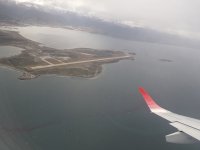Hi,
I am a mechanical engineer living far from USA, my city is 900km north of Antartica´s shores on an island south of Argentina. Here weather is harsh. I want to have a plane capable of carrying me, my two kids and luggage in comfort at 165 knots TAS, doing 1500 miles trips split in two legs. There are a lot of RVs but very few RV-10 in my country, I have to go to some EAA meetings and be lucky to see one in order to talk to the owner. There is one that made it to Oshkosh some time ago. But in the meanwhile winter is coming and I have time to plan and learn about the aircraft I am willing to build. I already have a turbocharged lyco 360 which is doing near 210hp. I know I will have to install this engine and some mods will be mandatory, but here it is hard to choose neither buy anything so I should be grateful to have it. And this is one of the reasons I want to make a good analysis before adapting this engine.
In order to learn about the aircraft I would like to load its characteristics in a software (https://www.pca2000.com/index.html). It has really worked perfect for other airplanes I have checked in the past for me and friends. Once you have a working model and calibrated with real data, its really easy to check different missions, engines and setups (bigger fuel tanks, etc) . I already purchased the pendrive from VANS with the RV10 plans, but I was missing some information and I will really appreciate your help with this.
Some of the data that is hard to get from the USB plans is:
.- Wings, vertical and horizontal stabilizers airfoils and their angles of incidence compared to the thrust line.
.- Weight of fuselage, wings and stabilizers without anything else attached to them.
.- Control surfaces´ angle of displacements and any schematics of the control mechanism lever ratios in order to assess trim and pilot input. I have a nice assembly drawing without any dimensions in order to draw it with the control surfaces in solidworks. How those control surfaces are balanced any dimensions for excentricities at their pivot point or additional weights.
.- Flaps displacement path.
Thanks in advance for your time reading these lines and excuse my english since its not the local language here. I already built a shred where I can build the aircraft, started buying some tools and talked to the VANs kit local dealers. In the meanwhile I will be reading VAF and trying to learn the most I can from the RV10s. I will share the end result for you to use with this software and I upload my results in the post once they are checked to be good enough.
Kind Regards!
Diego
I am a mechanical engineer living far from USA, my city is 900km north of Antartica´s shores on an island south of Argentina. Here weather is harsh. I want to have a plane capable of carrying me, my two kids and luggage in comfort at 165 knots TAS, doing 1500 miles trips split in two legs. There are a lot of RVs but very few RV-10 in my country, I have to go to some EAA meetings and be lucky to see one in order to talk to the owner. There is one that made it to Oshkosh some time ago. But in the meanwhile winter is coming and I have time to plan and learn about the aircraft I am willing to build. I already have a turbocharged lyco 360 which is doing near 210hp. I know I will have to install this engine and some mods will be mandatory, but here it is hard to choose neither buy anything so I should be grateful to have it. And this is one of the reasons I want to make a good analysis before adapting this engine.
In order to learn about the aircraft I would like to load its characteristics in a software (https://www.pca2000.com/index.html). It has really worked perfect for other airplanes I have checked in the past for me and friends. Once you have a working model and calibrated with real data, its really easy to check different missions, engines and setups (bigger fuel tanks, etc) . I already purchased the pendrive from VANS with the RV10 plans, but I was missing some information and I will really appreciate your help with this.
Some of the data that is hard to get from the USB plans is:
.- Wings, vertical and horizontal stabilizers airfoils and their angles of incidence compared to the thrust line.
.- Weight of fuselage, wings and stabilizers without anything else attached to them.
.- Control surfaces´ angle of displacements and any schematics of the control mechanism lever ratios in order to assess trim and pilot input. I have a nice assembly drawing without any dimensions in order to draw it with the control surfaces in solidworks. How those control surfaces are balanced any dimensions for excentricities at their pivot point or additional weights.
.- Flaps displacement path.
Thanks in advance for your time reading these lines and excuse my english since its not the local language here. I already built a shred where I can build the aircraft, started buying some tools and talked to the VANs kit local dealers. In the meanwhile I will be reading VAF and trying to learn the most I can from the RV10s. I will share the end result for you to use with this software and I upload my results in the post once they are checked to be good enough.
Kind Regards!
Diego







